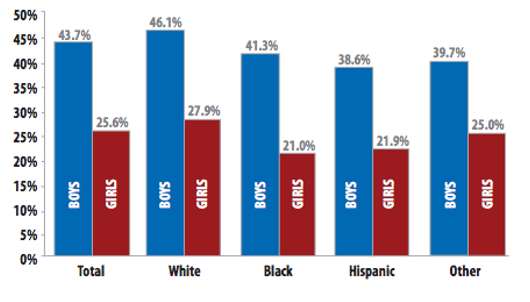Trends Related to Childhood Obesity
Health care professionals along with lawmakers, parents, and teachers are nowadays deeply concerned with the increased rates of childhood obesity as well as the potential risks it brings. One of the most prominent trends related to obesity in children is the increased spread and availability of high-calorie drinks and food in schools and shops. The second trend relates to some changes that occur in families, for instance, a single parent that takes up an additional job and spends less time at home, causes the child to crave more unhealthy food when there is no one to see or stop him or her.
The third trend is the decrease in the expenditure of energy linked to the fact that modern children spend much less time playing outside and much more time sitting at home playing video games or watching TV shows. It is important to note that none of the trends is a contributive factor to obesity itself, rather, the combination of such trends leads to potential childhood obesity (McLanahan, 2006, p. 19).
Possible solutions for childhood obesity encompass three levels: educating parents and caregivers about the possible risks, encouraging the availability of affordable and healthy food options, and promoting increased physical activity. Even though the steps taken to reduce the obesity rates will not be easy, they are necessary for improving the well-being of the growing generation.
Childhood Obesity Solutions
Educating parents about childhood obesity is one of the most important solutions since they play a dominant role in battling the issue. Thus, educational programs targeted at teaching parents the basics of nutrition, how to shop for healthy food for their children, how to cook the food, as well as how to encourage their children to move more should become the primary step towards battling childhood obesity.
Lawmakers and health care professionals should further collaborate on the issue of availability of fresh and healthy food both in schools and in stores. The food prices set on healthy organic products are nowadays too high so that the behavior of average families has shifted to pick cheaper energy-dense food, which is unhealthy for their children. Furthermore, according to the report conducted by the White House Task Force (2010), the prices on vegetables have grown twice over the last thirty years (p. 55). The current agricultural policies do not allow farmers to sell their products for cheap; thus, there is a high need for urgent changes in the policies.
Lastly, the public should raise awareness of the fact that every child and adolescent requires one hour of physical activity a day. The graph below (Figure 1) shows the percentage of high school students that get at least one hour of exercise a day:

As seen in the graph, girls are far less active compared to boys, and white boys are the most active among their peers. Because girls are less active, some specific school or general public programs should encourage their physical activities, sports, and games, educating them on the benefits of healthy living. Boys should also be encouraged not only to move but also to engage in community activities where they can make friends and share a common interest in an active lifestyle.
Benefits of Childhood Obesity Prevention
The combination of the three strategies of childhood obesity prevention can become a way of bringing benefits to the lives and well-being of the growing generations. Through the use of carefully designed and evaluated interventions and programs that will educate parents and children on the negative effects of childhood obesity, there will be an increased awareness among the public in the regular physical activity and the healthier choices of food (Institute of Medicine, 2005, para. 14).
Furthermore, the effective improvements related to dealing with childhood obesity will result in the environmental changes that, in turn, will provide a climate for major improvements in the community (Social Issue Report, 2011, p. 4).
Concluding Remarks
To conclude, childhood obesity is one of the major points of concern not only for the American community but also for the population worldwide. It can be caused by several factors; however, among the trends are the long absence of a parent at work, wide availability of unhealthy food at drinks at school, as well as the decrease in the overall physical activity in children due to the spread of computer and video games technologies.
Thus, the major areas of childhood obesity mitigation and prevention are linked to the three trends: parents should be educated on the effects of childhood obesity, the pricing policies on healthy food should be changed, children should be encouraged to move more and engage in physical activities. The changes will not occur fast; however, it is important to remember the benefits such improvements will bring to the community.
References
Exercise in High School Students. (n.d.). Web.
Institute of Medicine. (2005). Preventing childhood obesity: Health in the balance. Web.
McLanahan, S. (2006). Childhood obesity. The Future of Children, 16(1), 3-224.
Social Issue Report. (2011). Childhood obesity prevention. Web.
White House Task Force. (2010). Solving the problem of childhood obesity within a generation. Web.